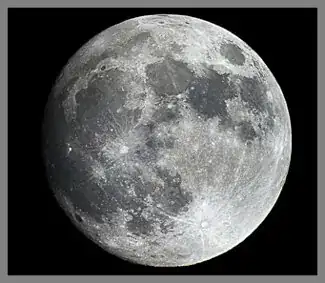Yes. Here's an example of a satellite that does exactly that:

Any sufficiently large body is going to have strong gravitational effects on the planet it orbits. We generally call these tides. As to the question: "Can these gravitational forces be strong enough to destroy buildings?" Well, it depends on how strong the buildings are.
Any gravitational effect on a planet is going to be capped by the gravitational force of the planet you're standing on. Why? Because more gravity than that and the planet would break apart. In general, the distance that two bodies can exist at, relative to one another, and be structurally sound due to hydrostatic equilibrium is defined by the Roche limit, which you can use to figure out how close together your planet and its satellite can be. Roughly defined, the Roche limit is the distance at which the difference between the cetripital force required to keep the planet orbiting and the force of gravity from the more distant body is equal to the force of gravity from the body you are standing on.
If you're standing on the larger body, you can get gravity ranging from around zero G to around 1.1G, if the satellite is close in size to the primary and orbiting very closely. Gravitational effects need not always be that high, however. If the satellite has a highly elliptic orbit around the primary. In that case, gravitational effects would range from this upper bound, when the satellite was at periapsis, to relatively negligible, when the satellite was at apoapsis.
For higher gravitational forces (i.e. above 1.1G), your best bet is to be standing on a relatively small body orbiting a relatively massive one at a great distance. If the front and back of your planet are about the same distance from the primary, relative to the distance of your planet to the primary, they'd experience about the same gravitational force from the primary. Again, since tidal forces can't be greater than the gravity of the planet you're standing on, apparent gravity will vary from a bit more than 0G to a bit less than 2G when your planet (which is now the sattelite) is at periapsis in its orbit around the primary.
Most buildings, if constructed appropriately, can probably withstand 2G of acceleration. The rampant volcanism caused by the intense tidal heating your planet/satellite will experience from the tidal forces in question will probably destroy quite a few, though.

Deepness in the Skyby Vernor Vinge has a great, recurring climate event on the main planet and discusses the engineering the society has to do around that. – Nathaniel Ford Jul 13 '16 at 21:20